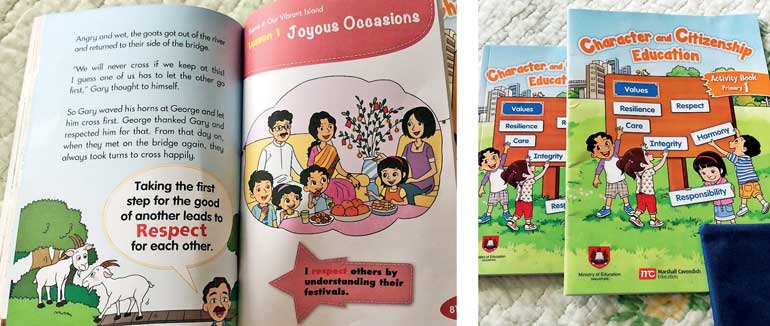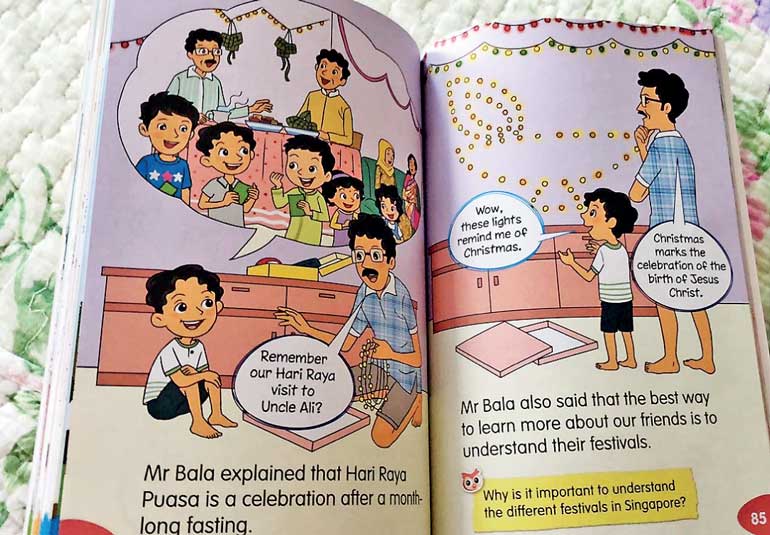Saturday Apr 20, 2024
Saturday Apr 20, 2024
Tuesday, 13 March 2018 00:00 - - {{hitsCtrl.values.hits}}

Singapore is an immaculate example of the interventionist approach that has succeeded in creating a cohesive and diverse community in stark contrast to the Singapore that suffered considerable racial riots in the ’60s. All Singapore students from Primary 1 undertake the Character and Citizenship Education module that proactively aims to eliminate racial biases

By Sharmil Ghouse
The ongoing sectarian violence is a result of frustrations that have been building over time boiling over. A few trigger points were required to bring the economically-disenfranchised youth onto the roads.
The extremely unfortunate death of a Sinhala youth, the wandha pethi saga and the recent election result which has been interpreted as a sign for the extremist Buddhists to take back control have all contributed to the tipping point.
The rural Sinhalese youth are frustrated because they have very minimal economic opportunities. And they have been continually let down by successive corrupt and incompetent governments. The highly-coordinated and organised way the riots are taking place suggests that these misguided youth are being strategically exploited by segments such as the BBS and the Mahason Balakaya to further their own divisive and bigoted goals.
For some time now, extremists on the Sinhala side have exploited social media to portray Sri Lankan Muslims as a conniving and deceitful group whose main aim is to turn Sri Lanka into an Arabesque state. 
What has compounded matters is the relatively recent transformation of Muslim attire across the group in general. From a Muslim perspective this transformation, where large swathes of women are seeing donning a hijab or a niqab and men sporting a long beard are viewed as a renaissance in faith and an upliftment in levels of spirituality towards their creator. In a liberal and progressive world such signs of outwardly devotion should be admired as a pursuit of religious liberty.
However, the dichotomy of Sri Lanka is such that there is a highly disproportionate number of people across all societal levels who take significant offense to this outwardly display of religious piety. Some see it as a regressive, impractical and non-contemporaneous mode of attire.
The danger is when such views are extended to fuel racist and bigoted views which then turn militant where the economically disenfranchised youths take to violence. Therefore, Sri Lankan Muslims should be more cognisant of the social context and the potential pitfalls even though their intentions are purely religious in nature and with no ulterior motives.
Racism, prejudice and intolerance are certainly not unique social dimensions to Sri Lanka. However, what stands out is the sheer proportion of people with racist views who are likely to take to physical violence. Just look at the comments on the numerous Facebook threads and WhatsApp chat groups that call for violent action against Muslims. Most of the perpetrators are likely to be keyboard warriors, however, the profanities and language used provides a glimpse into their thinking and mindsets.
The takeaway here is that Sri Lanka is a highly polarised society with a very disproportionate number of racists who are willing to take to violence and where the fundamentals have not changed since ’83.
So how should we change these entrenched racist tendencies? This article proposes three solutions.
Eliminate economic disenfranchisement
The first solution is to eliminate the economic disenfranchisement by creating decent employment opportunities. It is a shame that successive Sri Lankan governments have been unable to create jobs in manufacturing at a scale comparable to the likes of Vietnam, Thailand or even Malaysia over the past three decades.
Sri Lanka has also not been successful at creating the service-oriented industries such as business process outsourcing at a level comparable to that of the Philippines. Without economic growth there will always be a frustrated undercurrent that will have a higher propensity to take to violence. And without transforming the education system it will be difficult to create the relevant skills that are necessary for manufacturing and service based industries.
Value entrepreneurship
The second solution is to create an environment and culture that values entrepreneurship. Anecdotal evidence suggests that the typical local university graduate would prefer the comfort and the benefits associated with a Government job.
Government jobs are not necessarily market driven, are highly inefficient and are typically packed with cronies affiliated with local or provincial governments. Instead school curricula must inculcate ideas of entrepreneurship that promotes the starting-up of businesses and risk taking.
Sri Lankans in general are natural improvisers and therefore a business-centric education early on in life will foster a sense of self sufficient students who will not grow up to expect hand-outs. The imminent trends with the internet of things, artificial intelligence and the gig economy are convenient pathways for future generations of Sri Lankans to leapfrog the current infrastructure limitations.
Educate children
The third and most important aspect to addressing the intrinsic racism and prejudices is to educate kids from a very young age to appreciate diversity, to respect religions and different thoughts and opinions and to indoctrinate ways to live in harmony.
Here, Singapore is an immaculate example of the interventionist approach that has succeeded in creating a cohesive and diverse community in stark contrast to the Singapore that suffered considerable racial riots in the ’60s. All Singapore students from Primary 1 undertake the Character and Citizenship Education module that proactively aims to eliminate racial biases.
The first recommendation to drive macroeconomic growth will require competent and incorruptible governance. That is wishful thinking based on recent history. However, incorporating the second two recommendations into the schooling system is not something difficult to do. Implementing these simple steps will set the platform for a unified Sri Lanka to focus on economic development rather than to implode due to cultural and religious differences.
The recent riots are potentially a prelude of what is to come if we don’t change approach and is a result of the deep social divide that is a result of economically dissatisfied youth who expend their pent-up frustrations on a very visible Muslim community who have been negatively portrayed in social media circles.
Short-term solution
The short-term solution is dependent on the vast majority of peace-loving and tolerant Sinhalese community taking a proactive approach to protect Muslims and their interests. This can be done by showing their solidarity with the Muslim community and by working hand-in-hand with the temples, Police and the Armed forces to clamp down when rioting occurs.
The Muslim community also needs to contextualise their resurgence in faith by calibrating their outwardly appearance to minimise negative sentiment especially across the sensitive masses. This writer continues to believe that Sri Lanka is a Sinhalese Buddhist country and with tolerance, understanding and respect all communities could live in harmony.
All Sri Lankan communities should work together to depoliticise the mechanisms at play where the primary objective is to spread discord to drive political advantages. The Government should also work with the social media organisations to clamp down on the nefarious and racist social media campaigns whose primary objective is to exploit the current social divides.
I sincerely request all communities to stay away from emotive, divisive rhetoric and actions of violence. Let’s work together to prevent the recurrence of a July ’83 and the ensuing sectarian conflict that set back the country many years of progress!